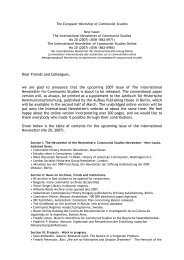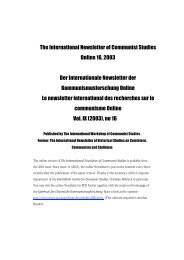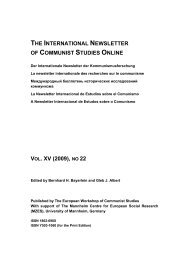Vol. XIII (2007), no 20 - The International Newsletter of Communist ...
Vol. XIII (2007), no 20 - The International Newsletter of Communist ...
Vol. XIII (2007), no 20 - The International Newsletter of Communist ...
Erfolgreiche ePaper selbst erstellen
Machen Sie aus Ihren PDF Publikationen ein blätterbares Flipbook mit unserer einzigartigen Google optimierten e-Paper Software.
<strong>The</strong> <strong>International</strong> Newletter <strong>of</strong> <strong>Communist</strong> Studies Online <strong>XIII</strong> (<strong><strong>20</strong>07</strong>), <strong>no</strong> <strong>20</strong> 31<br />
prolonging the First World War, or in facilitating the advent and spread <strong>of</strong> Bolshevism. To<br />
take one obvious measure <strong>of</strong> comparison: <strong>of</strong> the $398 million in gold shipped by Nazi<br />
Germany to Switzerland from 1939 to 1945, Lebor estimates some $289 million worth was<br />
obtained from the looting <strong>of</strong> central banks in occupied countries, plus an unspecified (though<br />
much smaller) amount taken from Holocaust victims. 61 This figure is less than the dollar value<br />
<strong>of</strong> gold sold abroad by the Bolsheviks in just 18 months during the murderous final stretches<br />
<strong>of</strong> the Russian Civil War (about $294 million), even without adjusting upwards to account for a<br />
quarter-century’s inflation. 62 Like the Nazis, the Bolsheviks obtained this gold by looting<br />
banks and robbing whole categories <strong>of</strong> people — and they procured substantially more gold,<br />
silver, and other precious stones (especially diamonds) from “class enemies” than did the<br />
Nazis from Holocaust victims. 63 Like the Nazis, the Bolsheviks had gold melted down and sold<br />
to obtain hard currency, which they used to purchase desperately needed war materiél.<br />
Unlike the Nazis, however, the Bolsheviks’ audacious looting <strong>of</strong> an entire continent has<br />
attracted little <strong>no</strong>tice from historians, aside from books in the “Anastasia” genre, which<br />
examine the legal claims <strong>of</strong> purported Roma<strong>no</strong>v descendants to the family’s lost fortune, and<br />
specialist art-historical studies on the provenance <strong>of</strong> looted paintings, antique books, and<br />
icons. 64<br />
61 Lebor, pp. 68-69.<br />
62 Roughly $214 million worth <strong>of</strong> gold was exported from Soviet Russia via Reval, Estonia, between May<br />
19<strong>20</strong> and April 1921, according to Charles Westcott, whose “Origin and Disposition <strong>of</strong> the Former Russian<br />
Imperial Gold Reserve,” was submitted from the U.S. Consulate in Paris to Washington on 21 April 1921,<br />
in U.S. State Department Reports on Russia, National Archives Annex (NAA) Micr<strong>of</strong>ilm Section 316, roll<br />
1<strong>20</strong>. A<strong>no</strong>ther 160 million gold rubles, or $80 million worth <strong>of</strong> gold, was sold and shipped by the<br />
Bolsheviks through Reval from May to November 1921, according to the report <strong>of</strong> Captain Kelley,<br />
Assistant Military Observer at the U.S. Commission in Reval, submitted to the State Department on <strong>20</strong><br />
March 1922. In NAA, M 316, micr<strong>of</strong>ilm roll 121.<br />
63 Lebor never does arrive at an estimate for the amount <strong>of</strong> Nazi gold sent to Switzerland which had its<br />
origins in the tooth fillings and crowns <strong>of</strong> Holocaust victims, which “dental gold” was processed through<br />
the so-called “Melmer” system. <strong>The</strong> closest to a concrete estimate <strong>of</strong> quantity Lebor found was in a<br />
postwar U.S. intelligence report describing “4,173 bags said to contain 8,307 gold bars inasmuch as<br />
these gold bars may…be determined to represent melted down teeth fillings and therefore classifiable<br />
as <strong>no</strong>n-monetary gold.” As such inferior gold was valued much less than fine gold bars (which sold at<br />
roughly $700 per kilo), this could <strong>no</strong>t have represented more than a few million dollars (and it had <strong>no</strong>t<br />
been sent to Switzerland, anyway).<br />
Irregular Bolshevik looting <strong>of</strong> aristocrats, “kulaks” and other class enemies, private bank safe deposit<br />
boxes, abandoned households, and churches between 1917 and 1922 was on a much larger scale. <strong>The</strong><br />
Gokhran, or State Treasury for the Preservation <strong>of</strong> Valuables, founded in February 19<strong>20</strong> to handle an<br />
ever-increasing volume <strong>of</strong> intake, processed many thousands <strong>of</strong> tons <strong>of</strong> loot, including fine gold ingots<br />
and high quality diamonds and other easily saleable jewelry. Just between 6 April and 18 July 19<strong>20</strong>, for<br />
example, the Gokhran received 21,500 carrots worth <strong>of</strong> diamonds, <strong>20</strong>,000 carrots <strong>of</strong> pearls, 6,300<br />
carrots in gold-plated jewels, plus <strong>20</strong> million Tsarist rubles ($10 million) worth <strong>of</strong> fine gold ingots and<br />
coin. Gokhran files at the Russian Government Archive <strong>of</strong> Eco<strong>no</strong>mics in Moscow (RGAE), fond 7632, opis<br />
1, del’ 4, list’ 8.<br />
64 <strong>The</strong> best overall survey <strong>of</strong> Bolshevik looting and laundering <strong>of</strong> arts and antiquities is Verkaufte Kultur.<br />
Die sowjetischen Kunst- und Antiquitätenexporte 1919-1938, ed. Waltraud Bayer (Frankfurt-am-Main:<br />
Peter Lang, <strong>20</strong>01), although the coverage <strong>of</strong> the Civil War years is spotty. <strong>The</strong> most thorough study <strong>of</strong><br />
the claims by Roma<strong>no</strong>v descendants is William Clarke’s <strong>The</strong> Lost Fortune <strong>of</strong> the Tsars. <strong>The</strong> Search for<br />
the Fabulous Legacy <strong>of</strong> the Roma<strong>no</strong>ffs (London: Orion, 1996; first published 1994). On artwork<br />
specifically, see Robert Williams, Russian Art and American Money, 1900-1940 (Cambridge: Harvard<br />
University Press, 1980). On antiquities, early memoir accounts include Percy Muir, “A Russian














